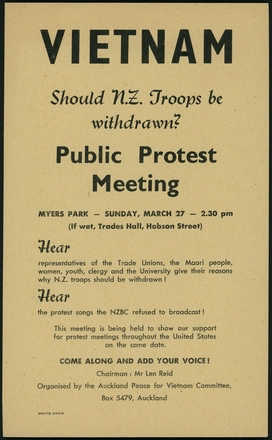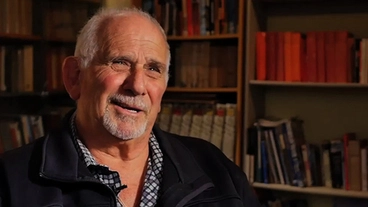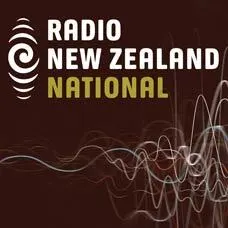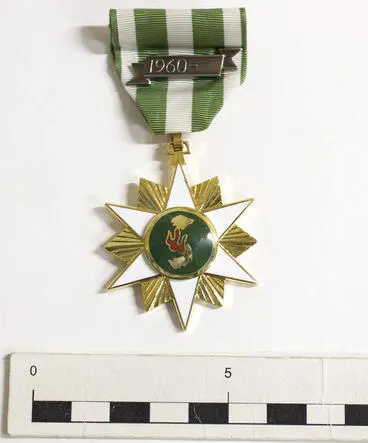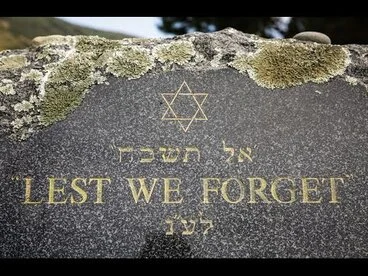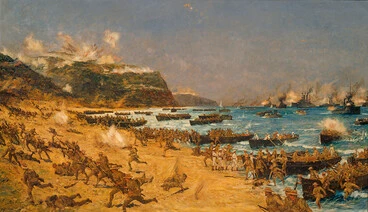New Zealand and the Vietnam War
A DigitalNZ Story by National Library of New Zealand Topics
In 1963 Prime Minister Keith Holyoake agreed to send non-combatant troops into the Vietnam War. This topic covers the anti-war protests, defence forces, action in Vietnam, apology from the Crown, compensation for veterans, and refugees from Vietnam. SCIS no: 1907663
Infantrymen in Vietnam, 1969
Manatū Taonga, the Ministry for Culture and Heritage
Vietnam War
Manatū Taonga, the Ministry for Culture and Heritage
Flag lowering ceremony, Vietnam
Manatū Taonga, the Ministry for Culture and Heritage
Vietnam war protests
DigitalNZ
Memories of Service 3 - Wayne Chester
NZ On Screen
Dien Bien Phu memorial
Manatū Taonga, the Ministry for Culture and Heritage
New Zealand in Vietnam - 50 years on
Radio New Zealand
Whiskey Company [electronic resource] : South Vietnam 1967-68.
National Library of New Zealand
Weapons of the Vietnam war
DigitalNZ
Vietnam War vet challenges US over Agent Orange
Radio New Zealand
Holyoake's reluctant commitment, 1964
Manatū Taonga, the Ministry for Culture and Heritage
VietnamWar.govt.nz [electronic resource] : memories of New Zealand and the Vietnam War.
National Library of New Zealand
Vietnam war hero Morrie Stanley dies
Radio New Zealand
Vietnam Vet's Apology (Part 1)
Radio New Zealand
Death in Hue 1969: Who Pulled the Trigger? - Salient. Victoria University Student Newspaper. Vol. 38, No. 6 April 10, 1975
Victoria University of Wellington
Vietnamese family
Manatū Taonga, the Ministry for Culture and Heritage
Medal, South Vietnam Campaign
Puke Ariki
Troops from Vietnam
Auckland War Memorial Museum Tāmaki Paenga Hira
Photographs of Vietnam War veterans marching to Parliament, Wellington
Alexander Turnbull Library
D.W. Vietnam War Shots
Alexander Turnbull Library
Peter Arnett on being prepared for action in the Vietnam War
Services to Schools
New Zealand’s foreign policy after the war
Services to Schools
Reluctant ally
Services to Schools
Teaching the Vietnam War at school
Services to Schools
New Zealand's Vietnam War timeline
Services to Schools
Memorandum of understanding
Services to Schools
Crown apology to Vietnam veterans
Services to Schools
Vietnam War
Services to Schools
Vietnam War
Services to Schools
Refugee Tran Lawrence is finally happy in his own skin
Services to Schools
John Bluett on Vietnam & Agent Orange
Services to Schools
A New Zealand Vietnamese family remembers
Services to Schools
Home fires burning: New Zealand's Vietnam War
Services to Schools
Primary sources and teaching activities
Services to Schools
Vietnam war pictures
Services to Schools
New Zealand and the Vietnam War
Services to Schools
Vietnam War with poetry and archives
Services to Schools
Photograph that haunted the world
Services to Schools
Sit-in at the Prime Ministers suite
This anti-Vietnam War sit-in was staged in June 1965. It was part of years of protest against America’s (and later New Zealand’s) involvement in the Vietnam War. This was New Zealand’s first televised war. It also gave rise to scores of protests by well-organised university students who objected to New Zealand and America’s involvement in the war on ethical and moral grounds. In New Zealand at the time, people wanted the government to have a more independent foreign policy rather than being pressurised by the US into joining the war. As seen in the photograph, a sit-in is a form of non-violent protest.
Alexander Turnbull Library
Vietnamese women and children at the Bong Son district dispensary
Along with the combat forces sent to Vietnam, the New Zealand Services Medical Team was deployed to provide humanitarian and civilian aid to the town of Bong Son province from May 1967 to December 1971. The team consisted of three medical officers, eight medics, a laboratory technician and two administrative staff. Lieutenant-Commander A. Green shown in the picture was in charge of the unit. They were armed for their own safety, and for the safety of their patients. The camp provided medical assistance to anyone injured in the war. This included civilians and also soldiers from both sides. The team worked hard. It is recorded they treated some 46,000 outpatients and 200,000 patients overall
Alexander Turnbull Library
Bill Rawiri, Vietnam war veteran
This is a photograph of Vietnam war veteran Bill Rawiri. The Online Cenotaph lists him as William Ernest Rawiri. Service number 388570. He was a Lance Corporal in the Royal New Zealand Infantry Regiment, who served in the Vietnam War. Around 35% of the New Zealand forces serving in Vietnam were Māori, as a result, there was a need for greater Maori cultural integration into the armed forces. The haka, karanga and wero all became part of the battalions’ cultural activities routine.
Alexander Turnbull Library
To the War! Any War
Loyalty to the British Empire was one reason that New Zealand soldiers fought in the Boer War, the First World War and the Second World War. Then in 1950 when communist North Korea invaded South Korea, the New Zealand government sent New Zealand soldiers to join an allied United Nations force formed to fight against North Korea. In the 1960s it was the Vietnam War where New Zealand (through the ANZUS treaty) found itself pressurised by America into joining the war. The soldiers in this cartoon are on their way to Afghanistan. This is a result of the government’s decision to send Special Air Service troops (at the request of the United States) to fight in Afghanistan.
Alexander Turnbull Library
"Vietnam was hell!"
The health of some New Zealand Vietnam War soldiers suffered after they were exposed to the herbicide called ‘Agent Orange’. This was used by the US military to clear forest cover in the Vietnam war. A different form of suffering occurred when returning war veterans were harassed and despised by some fellow New Zealanders who disagreed with the government’s decision to send troops to the Vietnam War. To make matters worse, the government (and successive administrations) did not officially recognise their service in Vietnam Some 40 years after the war, then Prime Minister Helen Clark on behalf of the Crown, made an apology to the war veterans in Parliament.
Alexander Turnbull Library
Jane Fonda, Vietnam war activist
This is a caricature of Jane Fonda, American actress, fitness guru, and once a famous anti-Vietnam War activist. America’s involvement in the Vietnam War generated huge protests in America. Many public faces joined the anti-Vietnam war movement and Jane Fonda was one of them. In 1972, the actress accepted an invitation to visit North Vietnam. She visited American POWs in Hanoi and toured areas bombed by the American forces. A photograph of her sitting on a North Vietnamese anti-aircraft gun earned her the name ‘Hanoi Jane’. This photograph and her visit resulted in some American lawmakers wanting her to be prosecuted as a traitor.
Alexander Turnbull Library
Portrait of Vietnamese President Ho Chi Minh
Ho Chi Minh or ‘Uncle Ho’ as he was also known was inspired by Russia’s communist revolution. By the late 1880’s, Vietnam, Laos and Cambodia, collectively known as Indochina were controlled by the French. Ho headed one of the most significant anti-colonial movements that started in Asia post-World War Two. Ho Chi Minh was president of the Democratic Republic of Vietnam (North Vietnam) from 1945 to 1969.
Alexander Turnbull Library
Willy Awatere killed in the Vietnam war
William and Hoa Awatere hold a photograph of William's uncle and Hoa's brother, Willy Awatere, who was killed by a landmine in the Vietnam War. American landmines used in the war (like the M16 landmines) caused extensive casualties and amputees. When triggered, the mine shoots up from the ground then explodes sending metal fragments in all directions causing fatal injuries. The M16 was known as the ‘jumping jack’ among Australians and New Zealanders. After the war, the Vietnamese government was left with a legacy of remnant active Vietnamese and American landmines which still cause havoc today.
Alexander Turnbull Library
Vietnam War shots
The Media (especially TV) played a very important role in the Vietnam War. Stories, interviews and photographs of the suffering, destruction, and cost of human life polarised and often outraged people. Most people remember the image of the ‘Napalm Girl’ running down the road naked and screaming in terror. Images like these captured the terror of the war and shocked at home in America. This image shows an injured Vietnamese child being carried from a military vehicle to (one hopes) a hospital. The man carrying her could be her relative. The people looking on seem deeply saddened and all too familiar with the casualties of war.
Alexander Turnbull Library
Anti-Vietnam War protest march banner, 1970
Massey University
National mobilisation against Vietnam war demonstration
Museum of New Zealand Te Papa Tongarewa
Māori artillerymen in Vietnam
Manatū Taonga, the Ministry for Culture and Heritage
Anti Vietnam war demonstration
Museum of New Zealand Te Papa Tongarewa
National Liberation Front flag
Museum of New Zealand Te Papa Tongarewa
Medical aid to South Vietnam
Manatū Taonga, the Ministry for Culture and Heritage
161 Battery Royal New Zealand Artillery in Vietnam War - 1965
Services to Schools
Lest we forget
Services to Schools
Refugees: a new life? Year 7 : Part 04 No. 2 : 1992
Services to Schools
Protests: Anti-nuclear, Vietnam, Māori, the 1950s to 1970s
Services to Schools
"The Vietnam War" explores both U.S. and Viet Cong perspectives
Services to Schools
Where can I find information about the Vietnam War?
Services to Schools
The Holocaust
DigitalNZ
Gallipoli Campaign
DigitalNZ
Anzac
DigitalNZ


